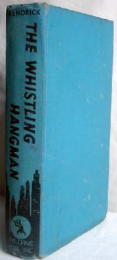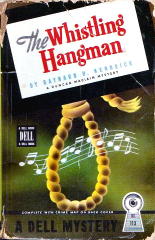Fri 10 Jul 2009
Reviewed by Mike Grost: BAYNARD KENDRICK – The Whistling Hangman.
Posted by Steve under Reviews1 Comment
BAYNARD KENDRICK – The Whistling Hangman. Doubleday Crime Club, US, hardcover, 1937. Robert Hale, UK, hardcover, 1959. Reprint paperback: Dell #113, US, mapback edition, 1946.

The staff of a large hotel in New York City is preparing for the arrival of an Australian millionaire who hasn’t seen his American family for twenty years. Murder swiftly ensues. Although this is a similar premise to A. A. Milne’s The Red House Mystery (1922), Kendrick’s novel has nothing else in common with Milne’s.
Baynard Kendrick’s The Whistling Hangman is a largely straightforward whodunit, with a mysterious murder solved by a detective. This pure whodunit structure makes it different from some of Kendrick’s other works, which can combine mystery with thriller elements. The detective here is Kendrick’s famous blind private investigator, Captain Duncan Maclain.
The murder method in The Whistling Hangman is itself a mystery. It is an example of the howdunit: a crime committed by a mysterious method, one that has to be figured out by the sleuth. Making it more complex than most howdunits: the crime is actually partly witnessed, by two different people. What they see and hear is itself baffling, and does not explain the killing.
Like several other howdunits, the murder in The Whistling Hangman is a borderline impossible crime. It does not seem to have any plausible explanation.
Like other Golden Age novels, Kendrick includes several subsidiary mysteries along the way. The focus is kept steadily on the unraveling of these mysteries. The book never stops dead in its tracks for soap opera passages or other filler. Each chapter usually brings new revelations about the tale’s mysterious events. We do learn a lot about the suspects’ personal lives — but this is all carefully interwoven with attempts to uncover those characters’ mysterious pasts.
I was able to figure out whodunit. But this is because I noticed some (but not all) of the numerous fair play clues to the killer Kendrick sprinkled through the book.
As in Kendrick’s later The Odor of Violets (1941), there are some Had I But Known (HIBK) elements:
● A viewpoint character through much of the novel is a woman, the hotel’s housekeeper.
● She has to enter some dark and frightening rooms.

● There are secrets about the characters’ past personal lives: also a HIBK staple.
It is rare for a male author like Kendrick to employ HIBK features. The book is not pure HIBK — the HIBK elements are mixed in with other tones and approaches.
The Whistling Hangman resembles in its settings Helen Reilly’s The Line-Up (1934). Both are principally set at lavish New York City residential hotels, occupied by wealthy families.
Both novels also have a secondary setting, which is similar in both books. That setting is a surprise, sprung in later chapters. I have no idea if these common settings are just a coincidence, or a sign of influence. The Whistling Hangman differs in that it concentrates on the hotel and its staff as a whole, while The Line-Up mainly looks at one family’s domicile within the hotel.
The luxury hotel in The Whistling Hangman and its elite staff anticipate Hugh Pentecost’s Pierre Chambrun series.
We learn a fair amount about the architecture of the hotel: an example of the Golden Age interest in architecture.
There are some technological ideas in The Whistling Hangman. Oddly, these involve not so much the murder or mystery plot, as some suspense passages in the finale. In these last chapters, Kendrick explores some of the technological features of a 1937 hotel.
July 10th, 2009 at 5:23 pm
I’ve missed this one, but sounds like I will have to correct that. I know some classical fans don’t care for some of the thriller elements in the Maclain books, but I’ve always thought they made them fresher and more fun to read.